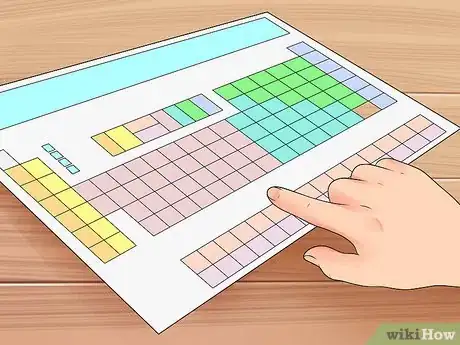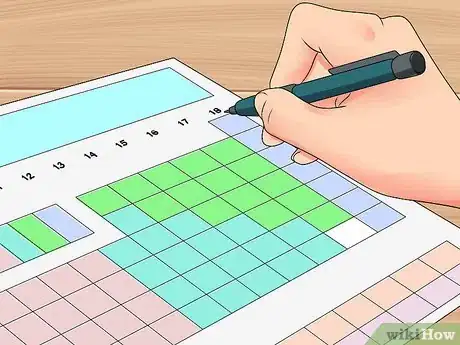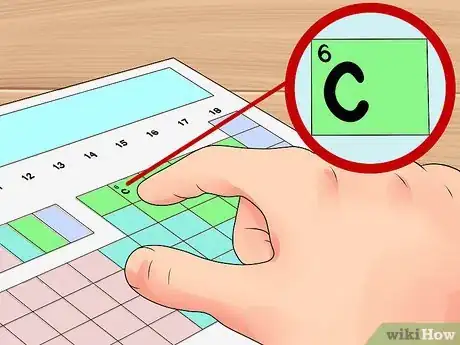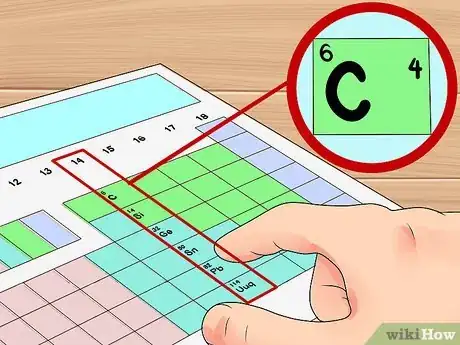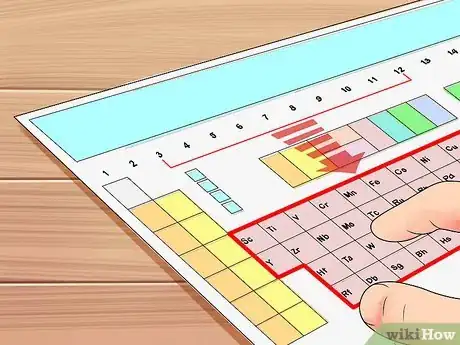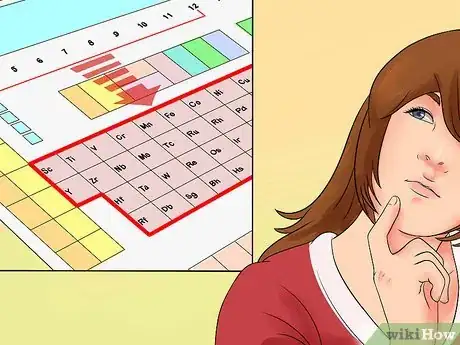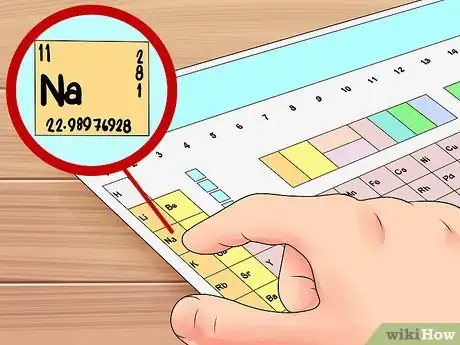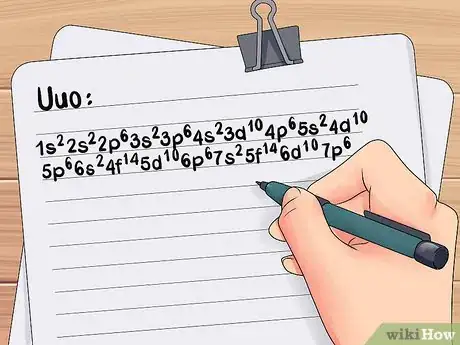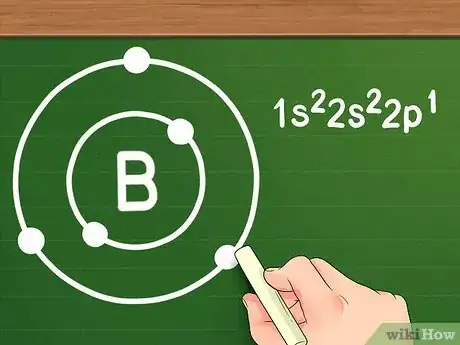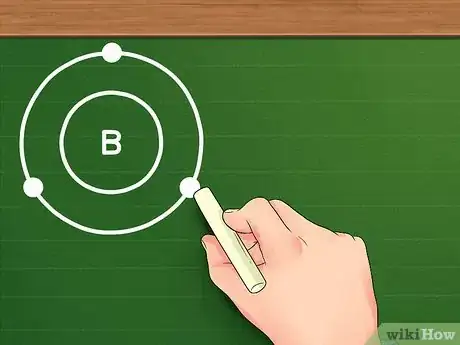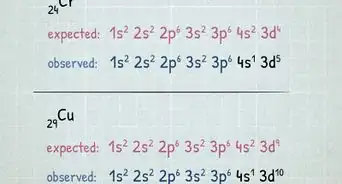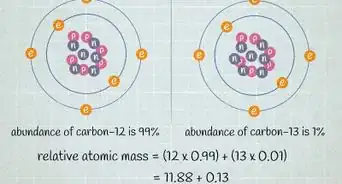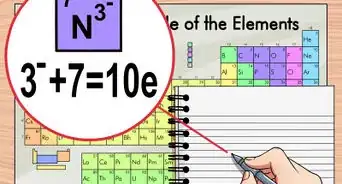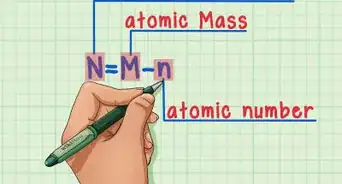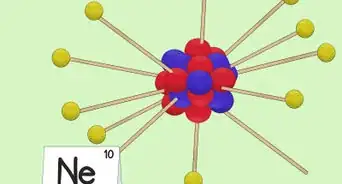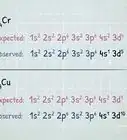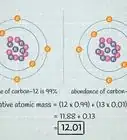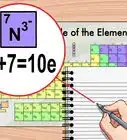This article was co-authored by Bess Ruff, MA. Bess Ruff is a Geography PhD student at Florida State University. She received her MA in Environmental Science and Management from the University of California, Santa Barbara in 2016. She has conducted survey work for marine spatial planning projects in the Caribbean and provided research support as a graduate fellow for the Sustainable Fisheries Group.
There are 7 references cited in this article, which can be found at the bottom of the page.
This article has been viewed 2,588,128 times.
In chemistry, valence electrons are the electrons that are located in the outermost electron shell of an element. Knowing how to find the number of valence electrons in a particular atom is an important skill for chemists because this information determines the kinds of chemical bonds that it can form and, therefore, the element's reactivity. Luckily, all you need to find an element's valence electrons is a standard periodic table of the elements.
Steps
Finding Valence Electrons With a Periodic Table
Non-Transition Metals
-
1Find a periodic table of elements. This is a color-coded table made up of many different squares that lists all of the chemical elements known to humankind. The periodic table reveals lots of information about the elements — we'll use some of this information to determine the number of valence electrons in the atom we're investigating. You can usually find these inside the cover of chemistry textbooks. There is also an excellent interactive table available online here.[1]
-
2Label each column on the periodic table of elements from 1 to 18. Generally, on a periodic table, all of the elements in a single vertical column will have the same number of valence electrons. If your periodic table doesn't already have each column numbered, give each a number starting with 1 for the far left end and 18 for the far right end. In scientific terms, these columns are called the element "groups."[2]
- For example, if we were working with a periodic table where the groups aren't numbered, we would write a 1 above Hydrogen (H), a 2 above Beryllium (Be), and so on until writing an 18 above Helium (He).
Advertisement -
3Find your element on the table. Now, locate the element that you want to find the valence electrons for on the table. You can do this with its chemical symbol (the letters in each box), its atomic number (the number in the top left of each box), or any of the other pieces of information available to you on the table.[3]
- For example purposes, let's find the valence electrons for a very common element: carbon (C). This element has an atomic number of 6. It is located at the top of group 14. In the next step, we'll find its valence electrons.
- In this subsection, we're going to be ignoring the Transitional metals, which are the elements in the rectangle-shaped block made by Groups 3 to 12. These elements are a little different from the rest, so the steps in this subsection won't work on them. See how to deal with these in the subsection below.
-
4Use the group numbers to determine the number of valence electrons. The Group number of a non-transition metal can be used to find the number of valence electrons in an atom of that element. The ones place of the group number is the number of valence electrons in an atom of these elements.[4] In other words:
- Group 1: 1 valence electron
- Group 2: 2 valence electrons
- Group 13: 3 valence electrons
- Group 14: 4 valence electrons
- Group 15: 5 valence electrons
- Group 16: 6 valence electrons
- Group 17: 7 valence electrons
- Group 18: 8 valence electrons (except for helium, which has 2)
- In our example, since carbon is in group 14, we can say that one atom of carbon has four valence electrons.
Transition Metals
-
1Find an element from Groups 3 to 12. As noted above, the elements in groups 3 to 12 are called "transition metals" and behave differently than the rest of the elements when it comes to valence electrons. In this section, we'll explain how, to a certain extent, it's often not possible to assign valence electrons to these atoms.[5]
- For example purposes, let's pick Tantalum (Ta), element 73. In the next few steps, we'll find its valence electrons (or, at least, try to.)
- Note that the transition metals include the lanthanide and actinide series (also called the "rare earth metals") — the two rows of elements that are usually positioned below the rest of the table that start with lanthanum and actinium. These elements all belong to group 3 of the periodic table.
-
2Understand that transition metals don't have "traditional" valence electrons. Understanding why transition metals don't really "work" like the rest of the periodic table requires a little explanation of the way electrons behave in atoms. See below for a quick run-through or skip this step to get right to the answers.
- As electrons are added to an atom, they are sorted into different "orbitals" — basically different areas around the nucleus that the electrons congregate in. Generally, the valence electrons are the electrons in the outermost shell — in other words, the last electrons added.
- For reasons that are a little too complex to explain here, when electrons are added to the outermost d shell of a transition metal (more on this below), the first electrons that go into the shell tend to act like normal valence electrons, but after that, they don't, and electrons from other orbital layers sometimes act as valence electrons instead. This means that an atom can have multiple numbers of valence electrons depending on how it is manipulated.
-
3Determine the number of valence electrons based on the group number. Once again, the group number of the element you are examining can tell you its valence electrons. However, for the transition metals, there isn't a pattern you can follow — group number will usually correspond to a range of possible numbers of valence electrons. These are:[6]
- Group 3: 3 valence electrons
- Group 4: 2 to 4 valence electrons
- Group 5: 2 to 5 valence electrons
- Group 6: 2 to 6 valence electrons
- Group 7: 2 to 7 valence electrons
- Group 8: 2 or 3 valence electrons
- Group 9: 2 or 3 valence electrons
- Group 10: 2 or 3 valence electrons
- Group 11: 1 or 2 valence electrons
- Group 12: 2 valence electrons
- In our example, since Tantalum is in group 5, we can say that it has between two and five valence electrons, depending on the situation.
Finding Valence Electrons With an Electron Configuration
-
1Learn how to read an electron configuration. Another way to find an element's valence electrons is with something called an electron configuration. These may at first look complicated, but they're just a way to represent the electron orbitals in an atom with letters and numbers and they're easy once you know what you're looking at.[7]
- Let's look at an example configuration for the element sodium (Na):
- 1s22s22p63s1
- Notice that this electron configuration is just a repeating string that goes like this:
- (number)(letter)(raised number)(number)(letter)(raised number)...
- ...and so on. The (number)(letter) chunk is the name of the electron orbital and the (raised number) is the number of electrons in that orbital — that's it!
- So, for our example, we would say that sodium has 2 electrons in the 1s orbital plus 2 electrons in the 2s orbital plus 6 electrons in the 2p orbital plus 1 electron in the 3s orbital. That's 11 electrons total — sodium is element number 11, so this makes sense.
- Keep in mind that each subshell has a certain electron capacity. Their electron capacities are as follows:
- s: 2 electron capacity
- p: 6 electron capacity
- d:10 electron capacity
- f: 14 electron capacity
- Let's look at an example configuration for the element sodium (Na):
-
2Find the electron configuration for the element you are examining. Once you know an element's electron configuration, finding its number of valence electrons is quite simple (except, of course, for the transition metals.) If you're given the configuration from the get-go, you can skip to the next step. If you have to find it yourself, see below:[8]
- Examine complete electron configuration for oganesson (Og), element 118, which is the last element on the periodic table. It has the most electrons of any element, so its electron configuration demonstrates all of the possibilities you could encounter in other elements:
- 1s22s22p63s23p64s23d104p65s24d105p66s24f145d106p67s25f146d107p6
- Now that you have this, all you need to do to find another atom's electron configuration is just fill in this pattern from the beginning until you run out of electrons. This is easier than it sounds. For example, if we want to make the orbital diagram for chlorine (Cl), element 17, which has 17 electrons, we would do it like this:
- 1s22s22p63s23p5
- Notice that the number of electrons adds up to 17: 2 + 2 + 6 + 2 + 5 = 17. You only need to change the number in the final orbital — the rest is the same since the orbitals before the final one are completely full.
- For more on electron configurations, see also this article.
- Examine complete electron configuration for oganesson (Og), element 118, which is the last element on the periodic table. It has the most electrons of any element, so its electron configuration demonstrates all of the possibilities you could encounter in other elements:
-
3Assign electrons to orbital shells with the Octet Rule. As electrons are added to an atom, they fall into various orbitals according to the order given above — the first two go into the 1s orbital, the two after that go into the 2s orbital, the six after that go into the 2p orbital, and so on. When we're dealing with atoms outside of the transition metals, we say that these orbitals form "orbital shells" around the nucleus, with each successive shell being further out than the ones before. Besides the very first shell, which can hold only two electrons, each shell can have eight electrons (except, again, when dealing with transition metals.) This is called the Octet Rule.[9]
- For example, let's say we're looking at the element Boron (B). Since its atomic number is five, we know it has five electrons and its electron configuration looks like this: 1s22s22p1. Since the first orbital shell has only two electrons, we know that Boron has two shells: one with two 1s electrons and one with three electrons from the 2s and 2p orbitals.
- As another example, an element like chlorine (1s22s22p63s23p5) will have three orbital shells: one with two 1s electrons, one with two 2s electrons and six 2p electrons, and one with two 3s electrons and five 3p electrons.
-
4Find the number of electrons in the outermost shell. Now that you know your element's electron shells, finding the valence electrons is easy: just use the number of electrons in the outermost shell. If the outer shell is full (in other words, if it has eight electrons or, for the first shell, two), the element is inert and will not react easily with other elements. Again, however, things don't quite follow these rules for transition metals.[10]
- For example, if we're working with Boron, since there are three electrons in the second shell, we can say that Boron has three valence electrons.
-
5Use the rows of the table as orbital shell shortcuts. The horizontal rows of the periodic table are called the element "periods." Starting from the top of the table, each period corresponds to the number of electron shells the atoms in the period possess. You can use this as a shortcut to determine how many valence electrons an element has — just start from the left side of its period when counting electrons. Once again, you'll want to ignore the transition metals with this method, which includes groups 3-12.
- For example, we know the element selenium has four orbital shells because it is in the fourth period. Since it is the sixth element from the left in the fourth period (ignoring the transition metals), we know that the outer fourth shell has six electrons, and, thus, that Selenium has six valence electrons.
Community Q&A
-
QuestionHow do we compute valence electron?
 saksham jainCommunity AnswerValence electrons can be found by determining the electronic configurations of elements. Thereafter the number of electrons in the outermost shell gives the total number of valence electrons in that element.
saksham jainCommunity AnswerValence electrons can be found by determining the electronic configurations of elements. Thereafter the number of electrons in the outermost shell gives the total number of valence electrons in that element. -
QuestionIf an atom has 33 electrons, how many valence electrons are there?
 Community AnswerIf the atom is not an ion, then we can say that the atom has 33 protons. This means it is element 33, which is arsenic. Then we know that it is not a transition metal, so we look and find the unit digit of its group number is 5, which means it has 5 valence electrons.
Community AnswerIf the atom is not an ion, then we can say that the atom has 33 protons. This means it is element 33, which is arsenic. Then we know that it is not a transition metal, so we look and find the unit digit of its group number is 5, which means it has 5 valence electrons. -
QuestionHow do I determine the atomic number of helium?
 Community AnswerThe number of protons equals the atomic number.
Community AnswerThe number of protons equals the atomic number.
Things You'll Need
- Periodic table of elements
- Pencil
- Paper
References
- ↑ http://www.ptable.com/
- ↑ https://www.scienceabc.com/pure-sciences/how-to-find-the-number-of-valence-electrons-in-an-element.html
- ↑ https://www.scienceabc.com/pure-sciences/how-to-find-the-number-of-valence-electrons-in-an-element.html
- ↑ https://www.scienceabc.com/pure-sciences/how-to-find-the-number-of-valence-electrons-in-an-element.html
- ↑ https://sciencing.com/parts-periodic-table-5414878.html
- ↑ https://sciencing.com/figure-valence-electrons-periodic-table-5847756.html
- ↑ https://chem.libretexts.org/Courses/Heartland_Community_College/CHEM_120%3A_Fundamentals_of_Chemistry/02%3A_Atoms_and_Elements/2.07%3A_Applications_of_Electron_Configurations_Valence_Electrons_and_Electron_Dot_Structures
- ↑ https://www.chem.fsu.edu/chemlab/chm1045/e_config.html
- ↑ https://chem.libretexts.org/Bookshelves/Physical_and_Theoretical_Chemistry_Textbook_Maps/Supplemental_Modules_(Physical_and_Theoretical_Chemistry)/Electronic_Structure_of_Atoms_and_Molecules/Electronic_Configurations/The_Octet_Rule
About This Article
To find valence electrons using a period table, first see if your atom is a transitional metal, which are the elements in the middle rectangle of the table. If the atom is outside this block, locate its group number along the top of the table. The ones digit in the group number is the number of valence electrons. To solve without a periodic table, find the electron configuration of the element and count the electrons into 1 group of 2, and then into shells of 8. The number in the last group is the amount of valence electrons. Read on for in-depth explanations and examples.
